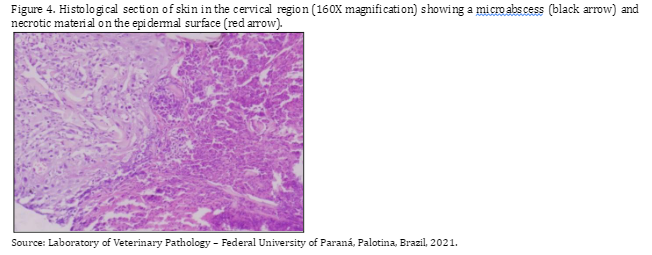Drug eruption in a cat following the use of multiple medications to treat systemic conditions
DOI:
https://doi.org/10.21708/avb.2023.17.2.10885Resumo
Drug eruption, also known as cutaneous adverse drug reaction, is a rare disease that is difficult to diagnose, requiring a combination of history evaluation, physical assessment, and histopathological examination. Clinically, it presents with variable signs, from mild urticaria to epidermal necrosis. Treatment consists of discontinuing the causative or similar medication; lesion management; and, sometimes, implementing systemic immunosuppressive treatments. The prognosis is generally good, except when there is systemic involvement or extensive skin necrosis. This study aims to describe the lesions, diagnosis, and evolution of a young cat presenting with drug eruption following the use of multiple medications for the treatment of systemic conditions. The patient underwent skin biopsy after showing progression of alopecic and localized lesions, which resulted in a suggestive diagnosis of superficial pustular drug eruption. Previous drug treatments were interrupted, but due to the lack of improvement in the lesion pattern, we chose to re-administer chlorambucil at a dose of 2 mg/cat every 48 h for therapeutic purposes. Up to the present time, the patient has been undergoing treatment and lesion management, with healthy-looking scar tissue and almost complete resolution of the skin lesions.
Downloads

Downloads
Publicado
Edição
Seção
Licença
Copyright (c) 2023 Acta Veterinaria Brasilica

Este trabalho está licenciado sob uma licença Creative Commons Attribution 4.0 International License.
Autores que publicam na Acta Veterinaria Brasilica concordam com os seguintes termos: a) Autores mantém os direitos autorais e concedem à revista o direito de primeira publicação, com o trabalho simultaneamente licenciado sob a Licença Creative Commons Attribution que permite o compartilhamento do trabalho com reconhecimento da autoria e publicação inicial nesta revista. b) Autores têm autorização para assumir contratos adicionais separadamente, para distribuição não-exclusiva da versão do trabalho publicada nesta revista (ex.: publicar em repositório institucional ou como capítulo de livro), com reconhecimento de autoria e publicação inicial nesta revista. c) Autores têm permissão e são estimulados a publicar e distribuir seu trabalho online (ex.: em repositórios institucionais ou na sua página pessoal) a qualquer ponto antes ou durante o processo editorial, já que isso pode gerar alterações produtivas, bem como aumentar o impacto e a citação do trabalho publicado (Veja O Efeito do Acesso Livre).


 Esta obra está licenciada com uma Licença
Esta obra está licenciada com uma Licença 